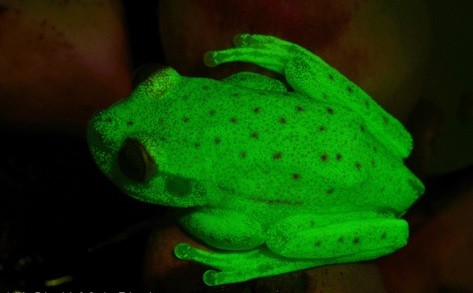By Ana Verayo, | March 15, 2017

The South American polka dot tree frog turns fluorescent in UV light. (Julián Faivovich/University of Buenos Aires)
Scientists have discovered the world's first fluorescent frog in Argentina. During an expedition, researchers made this discovery by accident when they were studying another frog species called the polka dot tree frogs.
A team of researchers from the Bernardino Rivadavia Natural Sciences Museum in Buenos Aires were able document this truly unique fluorescent frog and revealed how this frog changes its appearance. During regular lighting or visible light, the Hypsiboas punctatus appears to have a dull, brownish green skin with a smattering of red dots. However, when exposed to ultra violet light, this frog eerily glows into a bright, almost neon green.
Like Us on Facebook
Fluorescence involves the ability to absorb light from your environment using short wavelengths and emit them back with longer wavelengths. Marine creatures usually possess this ability and it is apparently very rare among terrestrial animals.
This translucent frog apparently uses a combination of lymph and glandular emissions to achieve this UV glow. Researchers say that this trait also can also enhance the frog's brightness in varying degrees, ranging from 19 to 29 percent. This will also depend on the amount of ambient light from its habitat.
Scientists assumed that the compound that causes the bluish green glow of the polka dot tree frog was not present in other vertebrates, however, this new discovery debunks that claim. According co-author of the study, Maria Gabriella Lagoria from the University of Buenos Aires, this is totally different from fluorophores that are found in other vertebrate species, that use proteins and polyenic chains.
This incredible discovery suggests that there is big possibility that other amphibians that can become fluorescent. More specifically, those that possess translucent skin similar to tree frogs.
According to the co-author of the study, Julián Faivovich from the University of Buenos Aires, scientists who are in the field should now carry a UV flashlight to discover more of these fluorescent frog species. This new study was published in the journal, Proceedings of the National Academy of Sciences.
-
Use of Coronavirus Pandemic Drones Raises Privacy Concerns: Drones Spread Fear, Local Officials Say

-
Coronavirus Hampers The Delivery Of Lockheed Martin F-35 Stealth Fighters For 2020

-
Instagram Speeds Up Plans to Add Account Memorialization Feature Due to COVID-19 Deaths

-
NASA: Perseverance Plans to Bring 'Mars Rock' to Earth in 2031

-
600 Dead And 3,000 In The Hospital as Iranians Believed Drinking High-Concentrations of Alcohol Can Cure The Coronavirus

-
600 Dead And 3,000 In The Hospital as Iranians Believed Drinking High-Concentrations of Alcohol Can Cure The Coronavirus

-
COVID-19: Doctors, Nurses Use Virtual Reality to Learn New Skills in Treating Coronavirus Patients








